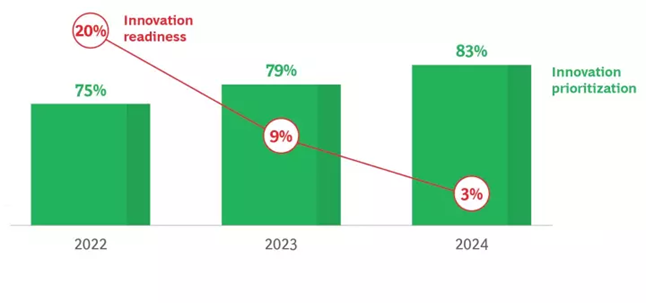In this insightful post, we explore how popular innovation methods can hurt your innovation efforts. You will discover six underrated innovation methods that can help you succeed and four overrated ones with questionable value.
We interview industry expert Magnus Penker of Innovation360 about choosing the right innovation methods and closing the ever-increasing innovation readiness gap. Read on to learn more about the tools and methods that can help with that. A VIEW OF INNOVATION METHODS – 6 UNDERRATED AND 4 OVERRATED
In a world that feels like a volatile cocktail of war, financial instability, global climate collapse and persistent poverty, it’s clear that the challenges we face are far from solved. Despite urgent initiatives like Scientific-Based Targets and global commitments to the 17 UN Sustainable Development Goals, many organizations continue to fall short.

A fair number of these organizations that fall short do so simply due to a lack of aspiration. About 19 % of the organizations in the InnoSurvey® database (populated with more than 10,000 organizations in 105 countries) simply do not have high aspirations for innovation. Those organizations will inevitably, maybe not this year or next but eventually, die. But more than 80% of the organizations do have high aspirations for innovation. Why is it then so that the gap between ’wanting to innovate’ and ‘succeeding with innovation’ grows yearly (BCG 2024)? I’d argue that one of the explanations is that we’re succumbing to myths. Myths about silver bullets which promise to solve all your needs with a blanket innovation method, prioritizing trendy methods over science-based practices and continuously changing the methods by each issue of HBR. The problem with this ‘tug of war’ ad nauseum is that it hurts innovation output. From my point of view, working side-by-side with a lot of the world’s largest organizations, I see this every day. “Do you have a template for how to drive radical innovation in the manufacturing industry?” is unfortunately a more common phrase than I’d want to credit Homo sapiens (wise human) for. And so is thinking that the executives have the answers to ‘the next big thing’. The truth in my experience is that innovation – this critical concept that stand between your organization’s long-term survival and its sliding into oblivion – requires critical thinking and an inclusive collaborative environment that are sharing a goal and are motivated to reach it together.
The 2024 Nobel Prize in Economic Sciences, awarded to Daron Acemoglu, Simon Johnson, and James Robinson, highlights how inclusive institutions foster innovation and long-term prosperity. Their research shows that countries with inclusive political and economic systems create environments where innovation thrives, driving sustainable growth. In contrast, extractive institutions that concentrate power stifle innovation and lead to stagnation. Their work underscores the importance of institutional reforms to foster innovation and reduce global inequality. Just as countries with inclusive institutions thrive, organizations must start with organizational context a key element of the, embrace inclusivity, root-cause thinking, and defining what value creation means for all stakeholders to drive long-term success. These elements are also guiding elements in the new ISO 56001 document (Innovation360 predicts more than 250,000 certified organizations by 2030: read here) However, despite the clear advantages of inclusivity, many organizations struggle to put these principles into practice, and the gap between innovation aspirations and readiness continues to grow.
This disconnect is evident in BCG’s June 2024 report, which revealed that while 83% of executives are prioritizing innovation, only 3% feel their organizations are truly ‘ready.’ Alarmingly, this readiness has dropped from 20% just two years ago, highlighting a growing challenge: it’s not enough to want to innovate – creating the right environment for it is where most organizations fall short.





